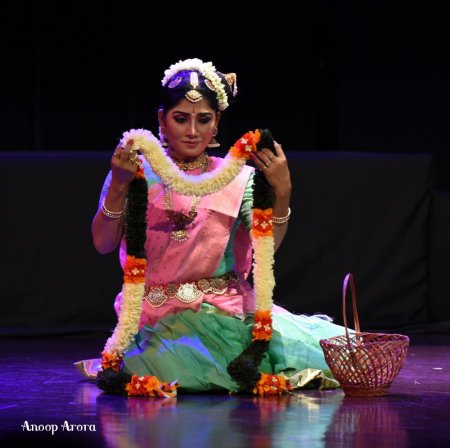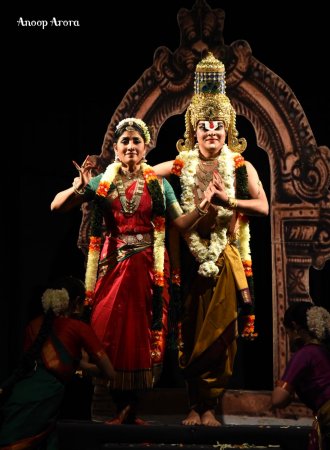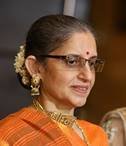
|   |

|   |
Jaya Seal Ghosh depicts Andal's journey in theatrical Bharatanatyam - Shveta Arora e-mail: arorashveta1806@gmail.com Photos: Anoop Arora April 24, 2024 In February 2024, Jaya Seal Ghosh presented 'Andal: The String of Love' at the IHC, Delhi. Jaya's training has continued throughout her life in the various cities she has lived in: under gurus Indira P. P. Bora in Guwahati, Vaibhav Arekar, Rajashri Shirke and Naresh Pillai in Mumbai and Thankamani Kutty in Kolkata. Currently, she is training under Rama Vaidyanathan. She is also a trained actress - an NSD graduate who is a recognized face from TV and has done 19 feature films in 8 languages. The production was about the various stages in the life of Andal, or Godha as the consort of Lord Ranganatha.  Pankoj Singha Roy as Periyazhwar In scene 1, Periyazhwar or Vishnuchitta is honoured with a procession by the Pandya king Vallabhadeva for his poetic genius and devotion to Sriman Narayana, and Lord Vishnu appears during this procession. The priest considered the lord his child and the Pallandu verses are offered to ward evil away from the lord. In the depiction, the group of dancers showed the priest, portrayed by Bharatanatyam dancer Pankoj Singha Roy, being honoured and given the Shree Sampradaya tilak. The priest has a darshan of Lord Vishnu and is at a loss for words to describe the moment of epiphany. He is not able to describe the beauty of the lord as he reclines on the snake. In scene 2, Vishnuchitta is rewarded with a girl child by the blessings of the lord. He finds her in his tulsi garden and names her Godha, meaning the sacred floral garland, and raises her with love and affection. A tulsi plant stood on the stage during this part of the presentation. Pankoj depicted the priest finding a girl child crying under it. The divine voice tells him that she is his child and he carries her home. He takes care of her and puts her to sleep in the cradle. In scene 3, Godha is a child playing with her friends. A group of little girls was on the stage, playing and frolicking together. Godha wore a side top knot on her head. She enacts Krishna as the cowherd who steals butter. She plays with the birds and the bees and talks to her parrot. She is taught the lesson of bhagavad sewa by the priests. The little girl in a green and pink saree who portrayed Godha had a charming visage. She is sent to collect flowers and string them together to make a garland for the lord. She is short and cannot reach the higher branches. She then remembers her divine love for the lord and finds the flowers placed miraculously in her hand.  Jaya Seal Ghosh as Godha In scene 4, Godha is shown to be a young woman. Jaya herself enacted the maiden Godha wearing a green and pink aharyam with the side top knot on her head and a long braid with the ornamental jada and kunjalam. In this scene, Godha is shown as a young woman who is in love with Vishnu/Ranganatha. She wants to try on herself the garland that she strings for him to see how it looks. Periyazhwar is furious to find a strand of her hair in the garland. He gets a new one made but it is Vishnu who tells him that he wishes to wear the garland made by Godha. As Vishnu wears the garland, it turns radiant and Godha is rechristened Andal or the one who has conquered the supreme. On the stage was a cutout of the Lord. Jaya as Godha collects flowers and strings them into a garland. She tries it on herself and looks at her reflection in a pond. She takes it to be offered to the lord when a strand of hair is discovered in it. The music included the recitation of the shloka 'kararvindam, mukharvindam...' The priest does a sashtang pranam when Vishnu accepts Godha's garland and she becomes Andal. This scene was mesmerizing. In scene 5, Andal matures in her journey of love. She wants to marry the lord. She writes the sacred verses with bhakti as their essence. For the bhaktas, these verses are the source of the awakening of the soul and immersing in pure bhakti.  Jaya depicted the morning scene when the birds are chirping, the butter is being churned and folks go to bathe. During this pious month, Andal tells her friends and the people of the pious town of Ayarpadi to observe the month as a rigorous effort at attaining the lord. She also befriends nature to help her attain the lord in marriage. Andal decks up her house, lights diyas, ties torans and draws a rangoli. She is struck by the arrows of love. The clouds will come, followed by the rain, the peacocks will dance, the bees will rest on the flowers and the calves will be fed milk by the cows. Her heart will flutter for the lord. She addresses the consort of Vishnu, Lakshmi, and asks her to wake him, the one whose shoulders are as powerful as that of an elephant. He is sleeping in the chamber adorned by lamps with his consort. Andal sings his praises and extols his deeds. As the lord awakens, the priests perform pooja and dress up Lord Vishnu. Amid the various musical instruments playing, the mridangam, conch and manjira, and the girls decking up the temple with toran and showering flowers, the couple ties the knot. A group of dancers featuring both boys and girls danced to show the merriment. The lord ties the mangalsutra around Andal's neck amid chants of 'anandam'. During this scene, the picture of the lord was replaced by Odissi and Bharatanatyam dancer Argha Chatterjee dressed as Lord Vishnu/Ranganatha. Argha is tall and well-built and along with the clothes, the jewellery and the accessories, the entire sequence made for a divine experience. The moment was mesmerizing as one could actually see the Godha mangalam happening.  The entire production had a theatrical flavour to it. The abhinaya by all the dancers portraying the various characters was sound. Jaya too emoted the myriad sentiments well. The nritta had a gentle touch to it. Jaya in her nritta interludes showed precision with more softness than usual. The group pieces displayed admirable coordination. All the scenes, together with the sets, props, costumes and ornamentation, had a theatrical aspect to them. Jaya's experience in acting and theatre helped her with the development of the production. The last scene was especially rousing. The vocals by Sudha Raghuraman heightened the magic of the production. Each piece was sung to amplify the soul of the poetry. Jaya conceived and directed the production, and the associate director was Bharatanatyam dancer Pankoj Singha Roy, who danced as Periyazhwar and is also a disciple of Rama Vaidyanathan. The music was by Sudha Raghuraman, script by Dr. Sridhar Vasudevan, and choreography by Dr. Vasudevan, Pankoj and Jaya. Later, I spoke to Jaya at length about the production. Training in theatre and dance I am from Guwahati, Assam, and I am a Bharatanatyam dancer first. My guru was Indira P.P. Bora, a graduate of Kalakshetra, Rukmini Devi Arundale's direct student. From there, I went to doing acting in theatre with NSD graduate Baharul Islam, and I got the idea of NSD, so I went to NSD from 1994 to 1997. In 1997, I went to Bombay when director Pankaj Parashar called me, and I started working with Pankaj ji on a serial. I did 30-35 ads with major ad firms, worked with Prabhudeva, Vikram, did a Kannada film with Shivraj Kumar. 'Uttara' was one of my films I really cherish and am proud of - it went to Venice and got the best director award for Buddhadev Dasgupta in 2000. I was in Venice as well and was nominated for best actress. Then I made a shift and did (popular Hindi serial) Kahani Ghar Ghar Ki as the new Parvati. I met Bickram Ghosh (well-known tabla exponent) in Kolkata, got married and shifted to Kolkata. And that was when I began pursuing dance again. Dance was always my first love. I was a Bihu dancer also in Assam. Dance was in my blood. I continued my dance because as soon as I came to Kolkata, I got pregnant within a few months so it was not possible for me to act anymore, and I had left Bombay, so I started dance. Here, I learnt from Guru Thankamani Kutty for 12 years, and now I am with Rama Vaidyanathan akka. In 2017, I got the best actress award at the Lonavala Film Festival for a film called 'Alifa'. But my dance sessions continued. Developing an Andal production In 2019, I went to the Natya Kala Conference which Rama akka was curating for the first time and I saw 'Naachiyar Next' by Anita Ratnam. I had heard about Andal from Thankamani Kutty aunty but I had never seen productions on Andal. I liked 'Naachiyar Next' a lot. I felt like there were similarities between her and Meerabai, whom we in the east and north knew of; we never knew anything about Andal. Bharatiya Vidya Bhavan in Kolkata was doing a dance drama festival. They asked me to do something and I said I'll do it on Andal. That's how I started. I called up Rama akka to tell her this is what I'm thinking, how to go ahead? She guided me and told me to go to Sridhar Vasudevan, who she said could guide me because he knows a lot about Andal. I came to Vasu anna, who guided me very thoroughly about Andal. Then he wrote the script. My vision was clear about what I wanted. Nachiyar's approach was very different; it was knowledge-oriented and based on Anita Ratnam's formidable research into Andal, which was wonderful. I wanted simply to feel Andal myself and the audience to feel her and her devotion to Vishnu / Ranganatha. Since I am from drama, I wanted a theatrical approach, like a movie, so people could see the journey of Andal. Sudha Raghuraman has used the ragas and melody so well to take my production to another level. You'll be surprised to hear, in this Andal project I have seen so many little miracles - it's been a completely spiritual journey for me. The rest of the team was coming by train at one time and I was stressed that the train was delayed. But finally, it was not delayed much. I was supposed to get the stage - I got it for a day and a half, from 6pm on the 21st to the next day. It was all the blessings of Andal and Vishnu. I was seeing the mandap in my head and they made it for me in one day. All these things are like miracles. I think Vishnu has blessed this production. And the journey with my beautiful team - there is so much resolve, and I could see the pure soul in all the children in my team, which you need for a devotional journey. The Delhi show was one of the best shows, the energy was so different, the vibe from the audience was very good. It has been a great journey for us, exploring, learning, correcting. Many well-known people attended and appreciated the show. I feel Andal is taking me on a journey. I want to take Andal to the world, not just out of Kolkata. People should know about Andal. I want to take the production to Guwahati. I feel god is trying to say something to me, that this production should go everywhere. I'm going through a journey and cherishing it because as an artiste and a human being, I think we should all go through a spiritual journey. Maintaining a theatrical approach I am from theatre and film so I see the story. I feel if I go with the story's flow the audience can connect with me nicely. Whatever we do in art, we want to connect with the audience. I don't see the point of making things too complicated - a very tough jati or anything. This teenager's journey, where she went, how she used to teach her friends, Vishnu's kripa, if you believe good things will happen to you etc. Finally, what she wants to say is - surrender to Vishnu and you will be content; this was her approach. The Periyazhwar character was portrayed wonderfully by Pankoj Singha Roy, my gurubhai - if you search for Periyazhwar, you will find that exact same look and he kept the dignity of the character intact. The four sakhis - they can be sakhis or they can be ladies from the village, like they are when they came later in the thillana part. I wanted to shift the characters and create that world of Andal. The last part, which (photographer) Innee Singh said gave him goosebumps, when Vishnu came - it was nice to hear that. I also don't know what happens to me... something happens to me (during that scene). And Argha Chatterjee, brilliant Odissi and Bharatanatyam dancer who was playing Vishnu - that day, you didn't notice but he was just dancing. He forgot to hold me and I had to touch him gently and remind him. He was in that trance of Vishnu. Every person in this production is going through that journey. I feel that the approach as a theatre person is to simply tell the story to the people so they feel it. They should not have to wonder what is going on here, I should not have to narrate this is what is happening in this scene, this in that scene - you should understand automatically. Abhinaya is very important. Dance abhinaya and theatre abhinaya is different. I was telling the children we will do this, then change, develop, evolve. This way, you are bringing the character alive I feel. The most important part is music. Each piece you listen, you will hum it. Light work is very important and dance needs proper lighting anyway.  The last scene It was amazing - I did the pranaam to Argha and touched him lightly on the finger, and then he remembered he had to hold me! He was standing there dressed as God. This was a moment of trance he went through. This was not originally in the choreography. I evolved it over successive performances. I thought, when Vishnu is coming, 'I can feel it, my intuition is telling me, he is coming, I can see him, no, no he is here, he is here, oh my god he is here.' That is the journey I wanted to show. The audience can relate to this vision. So I went right up to Vishnu and fell to the floor so that Vishnu should be highlighted. After that I am in surrender; that was what I wanted to show. I think I'm in the right place as a director also - the message I wanted to give to the audience, I think I am getting it across. I'm very grateful to all my gurus and my parents' blessings. My team has done a great job. I want specially to name one person, Dr. G.V. Subramanian, the director of Bharatiya Vidya Bhavan in Kolkata, who really helped us in this production throughout. He is doing really great work in Kolkata and he helps any artiste who comes to him. Style and innovation We have danced it in normal Bharatanatyam style. The choreography was by Vasu anna. I wanted Andal's softness. Like in the Vrindavan scene, I used gently swinging, articulating the waist movements. Nothing harsh. There is precision when we dance in our recitals but in this it was Andal dancing, not Jaya Seal Ghosh, and I wanted to keep that feel. Suddenly if I do a precise and correct movement it will distract from the feel of Andal, so I kept that softness. I love the four ragas and I love doing the abhinaya piece. Ornamentation In NSD, they teach us everything from costumes to aesthetics. I paid attention to all this - I got saris from Nalli in Kolkata. Thanks to Vasu Anna for clearing the doubts about Andal's look. Like for Periyazhwar, he minutely explained the design to be drawn on the hands. We all researched our characters as well. I'm a perfectionist and very finicky. Like I have chosen the mala for Andal specifically. I am thankful that being an actress, I am able to bring a different vision to my work and I am enjoying this.  Shveta Arora is a dance-mad writer who chronicles classical dance events in Delhi (and also those online). In 2009, she started the blog Kala Upasana at delhiculturecomment.blogspot.com, where she began posting her own writing along with photographs clicked by Anoop Arora, her husband. She's been dancing all her life as a devotee, but resumed her formal training in Kathak in her 50s and has passed her fifth year Kathak exams. |